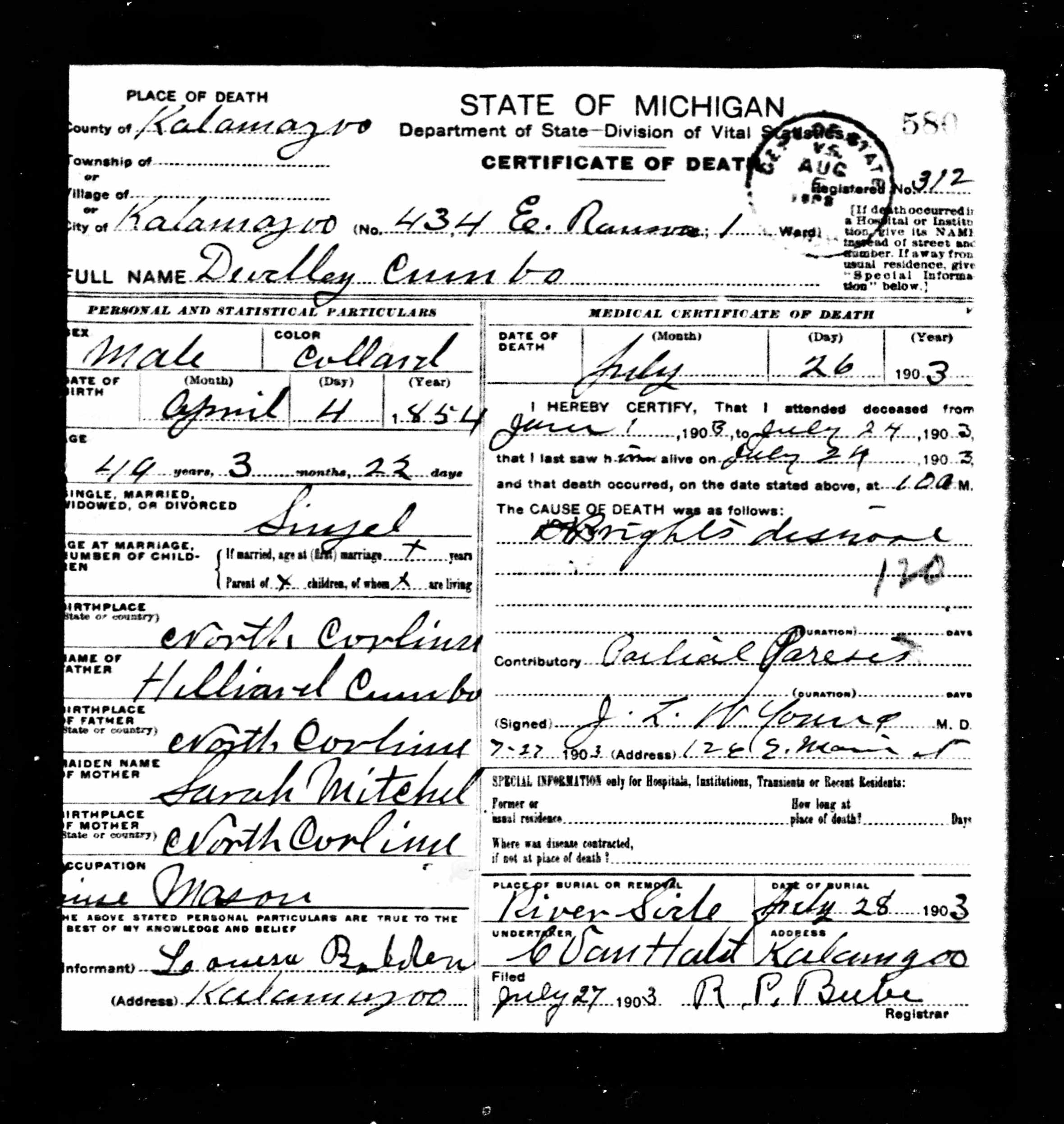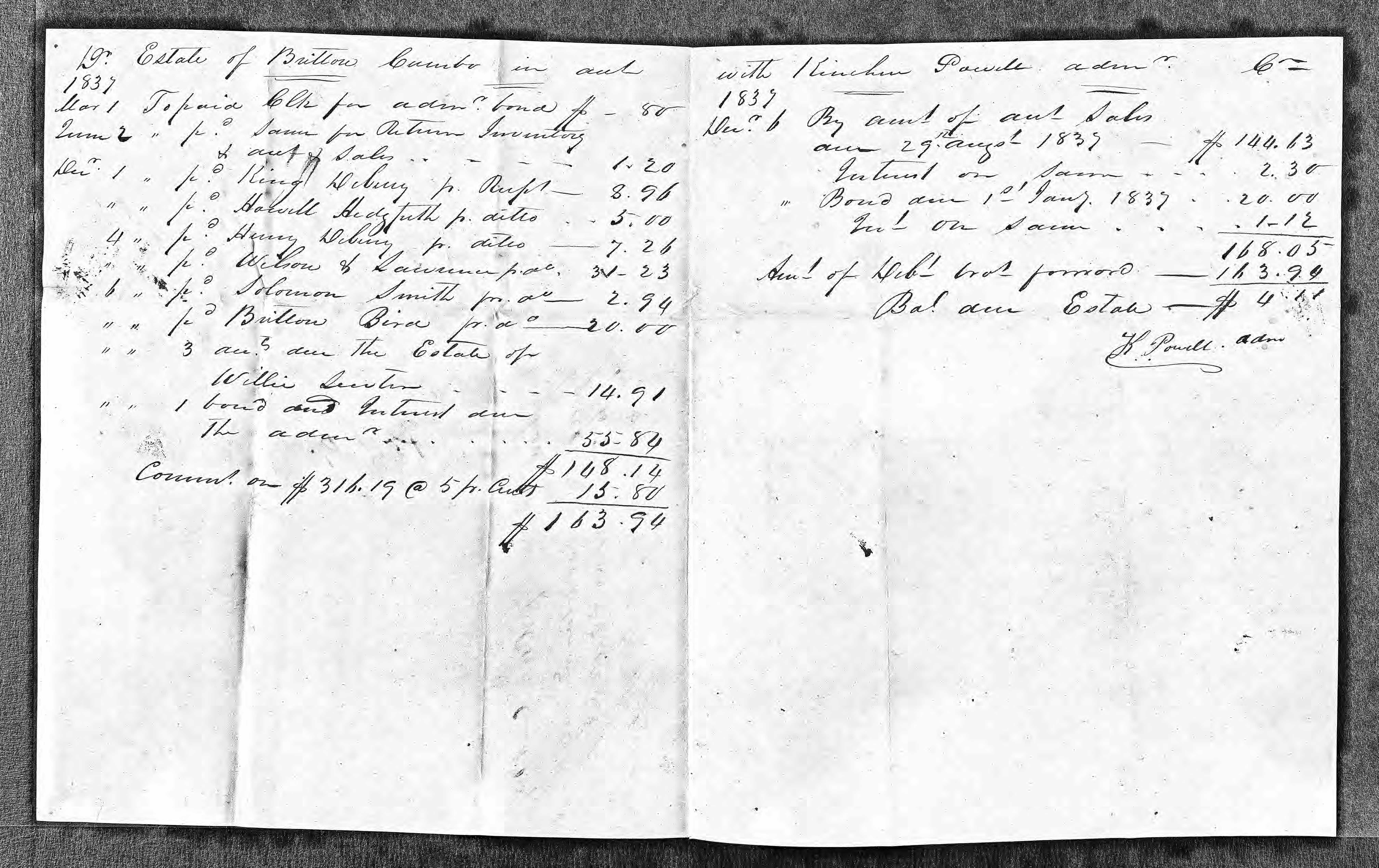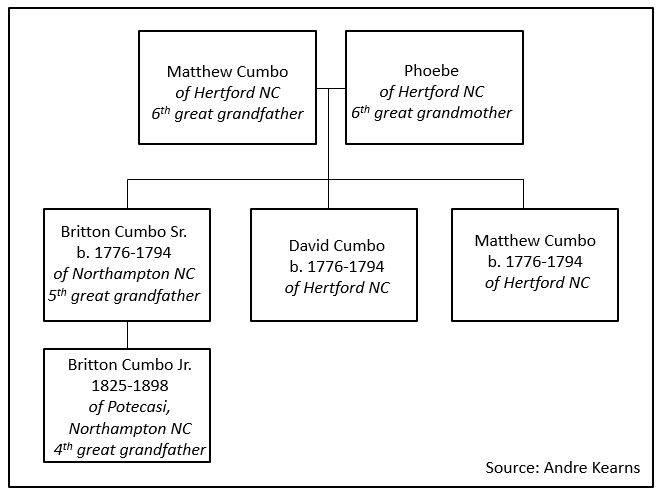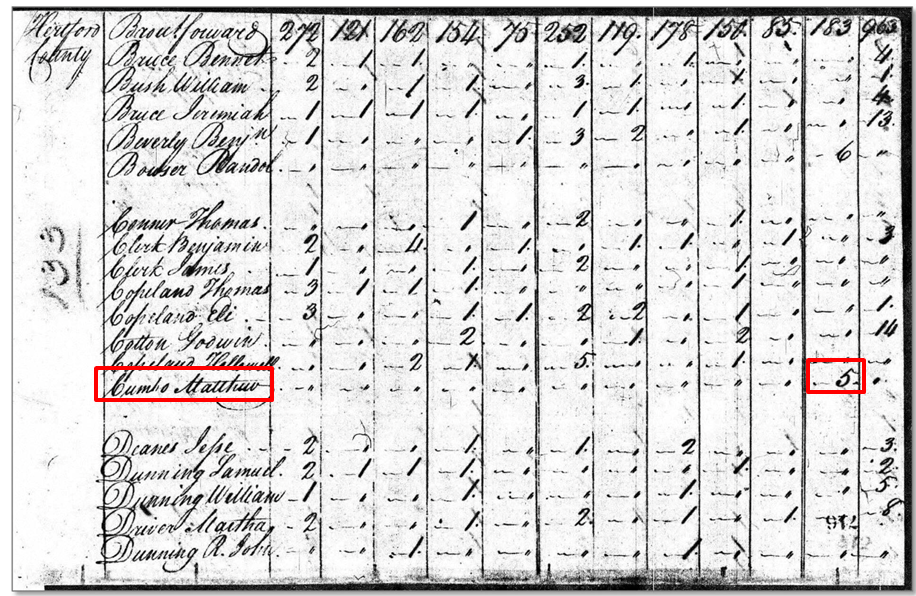By Andre Kearns 1
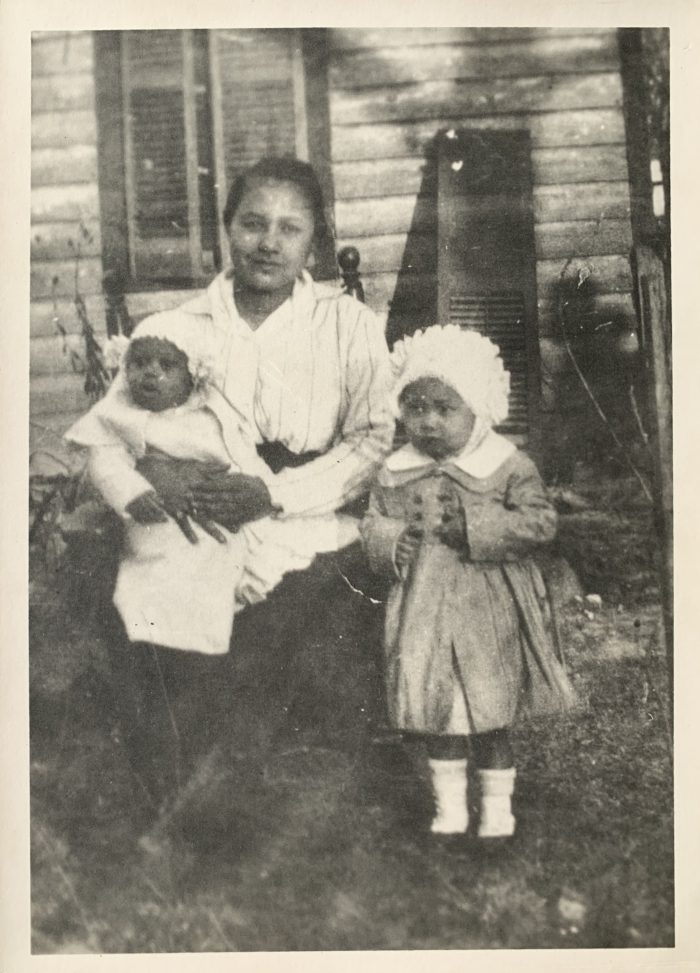
This photo is of my great grandmother Sarah Ann “Annie” Biggs Richards (1902-1930), daughter of Florence Cumbo Biggs, with my grandfather James Edward Richards (lap) and grand aunt Ernestine Richards (standing). My great-great grandmother Florence is the most recent ancestor in his family to be born with the surname Cumbo.
Abstract
The Cumbo Family is one of the earliest documented families in English America. Cumbo ancestors were among the first Africans arriving in Virginia prior to 1630. Over successive generations, many Cumbo family branches either maintained Black or mixed-race (mulatto) identities, passed into white communities (Melungeon, Portuguese or Irish) or fully embraced Native-American (Lumbee, Tuscarora, Saponi or Meherrin) identities. Cumbo descendants today self-identify across all of these racial groups. Additionally, as the Cumbo family grew, so did variations of the name, which expanded to Cumba, Cumbee, Cumby, Cumbia, Combo, Cumber, and others. This article explores the lineage and history of an African American Cumbo Family.
Introduction:
Ever since I watched the miniseries Roots as a child, I’ve been on a quest to explore and trace my family connection to Africa. I dreamt of the potential to trace back to a named ancestor in Africa. To identify my family’s Kunta Kinte.
Lack of documentation caused by slavery creates significant challenges for African Americans to trace their named ancestors over hundreds of years and many generations through the domestic slave trade to a port of entry, slave ship and African port of origin. Discovering that I descend from the Cumbos, an African-descended family who lived free in America centuries prior to emancipation, created the possibility to trace my lineage to named African ancestors.
First Generation:
Africa to Virginia – Cumbo Family Origins
1. EMANUEL CUMBO Senior and Joan (the mother) are the first generation of the Cumbo family line. Emanuel (father) and Joan were born around 1600 and 1610 in Ndongo2. They arrived in Point Comfort, Virginia sometime between 1619 3 to 16284. From Point Comfort, they were bound to landowners at Archers Hope Creek in James City County, Virginia. In 1638 Richard Kemp lists “Emanuel, Negro” among numerous headrights to secure 840 acres of land on Archers Hope Creek in James City County56. The next year “Joan, a Negro” is listed among headrights for 1,200 acres to William Davis, Kemp’s neighbor at Archers Hope Creek7.
Since Emanuel (father) and Joan arrived with no fixed-term indentured service contracts, they labored as bonded servants, enslaved in practice8. As they labored, slavery was rapidly forming in Virginia through custom, court rulings and laws9. White landowners misused the headright system which was established in Virginia in 1618 to recruit labor for the colonies. Landowners exploited Africans like Emanuel and Joan as headrights by using them to secure new land holdings over and over without ever having to transfer land patents to them.
Emanuel (father) tried to escape his bondage for freedom. In 1640 he was serving William Pierce in York County which adjoins James City County. He hatched a plan to escape under the cover of night with 6 white servants. They all were caught sailing down the Elizabeth River to Norfolk. Emanuel was whipped, branded, and returned to bondage10. His dreams of freedom would have to be realized through his son.
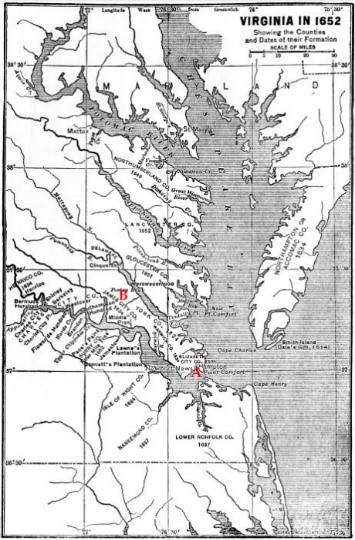
English North America
Virginia Counties in 1652 11
Second Generation:
The Life of Emanuel Cumbo
2. EMANUEL CUMBO Junior (Emanuel Sr.1) was born around 1634 to Emanuel (father) and Joan in James City County. His parents wanted him to have the freedom they were denied12. They leveraged relationships with those for whom they labored over many years to petition the Virginia legislature for their son’s freedom. They succeeded. In September 1644 the Virginia House of Burgess ruled him to be an indentured servant with a 21-year service term and not a slave for life13.
On 18 April 1667, two years after Emanuel Cumbo Junior was freed from his 21-year bondage, he took ownership of 50 acres of land in Archers Hope Creek where his mother and father labored. Cumbo obtains his property from land formerly deeded to William Davis, who had listed Emanuel’s mother Joan among the headrights required to claim it in 1639, and adjoining land owned by Richard Kemp, who listed his father Emanuel as a headright in 1638.
By September 1667, the Virginia Assembly declared baptism does not free enslaved people14. Had Emanuel Cumbo’s timeline shifted a few years, perhaps he would not have achieved freedom. But he did, making him and his descendants’ free people in America from that point forward. Many Cumbo descendants in America today trace their ancestry back to Emanuel Cumbo.
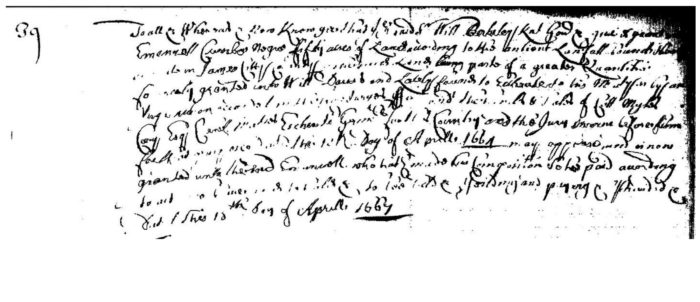
Emanuel Cumbo’s 18 April 1667 land grant
The 1667 land grant transcription provides evidence of early Angolan acquisition of land in colonial English America:
To all &c Whereas &c Now Know yee that I ye said Sr Will Berkeley Knt [Knight] Govr [Governor] &c give & grant unto Emanuell [Cumbow] Negro ffifty acres of Land according to the ancient Lawfull bounds thereof scituate in James Citty County the said Land being parte of a greater Quantitie formerly granted unto Willm Davis and Lately found to Escheate to his Maty [common abbreviation for Majesty] as by an Inquisition recorded in the secretary’s office undr [under] the hands & Seales of Coll [Colonel] Myles Cary Esqr [Esquire] his Maties [Majesty’s] Escheater Genll [General] for the sd County and the Jury sworne before him for that purpose dated the [18th?] Day of Aprill 1667 may appeare, and is now granted unto the said Emanuell who hath made his Composicon [Composition] to bee paid
Connecting the Dots: An African American Cumbo Family
I descend from the Cumbos through my mother, grandfather, and maternal great grandmother, all Americans of African descent who grew up in Suffolk, Virginia located in the tidewater area of the state, less than an hour from Point Comfort (Hampton, Virginia).
Elizabeth Florence Cumbo (known as Florence), my great-great grandmother in this line, born around 1866 in Northampton County, North Carolina (an hour’s drive from Suffolk) is the most recent ancestor in my family to be born with the surname Cumbo15. Eight generations and 266 years separate her from Emanuel Cumbo Senior.
Connecting the dots from Florence to Emanuel required application of a variety of research methods, made possible by documentation available on free people of color. I researched land, tax, church, court, census and estate records, some dating back to the early 1600s for direct evidence of ancestral connections. The uniqueness of the last name Cumbo with origins in Africa helped to apply a cluster analysis to identify family connections and build proofs where direct evidence is absent16. Once I researched and assembled my pedigree, I reviewed it with a critical mind to ensure ancestor birth dates fit proposed parent-child relationships, and that ancestral locations viewed over generations represented a coherent family migration pattern over time.
Third Generation:
First Cumbo Generation Born Free
Cluster analysis is a valid genealogical research approach where in a particular area all available documentation on a particular family, will reveal critical information on a family’s ancestry. As a result of the unique Cumbo surname, cluster analysis identified Richard Cumbo, as the son of Emanuel Cumbo and was born circa 1667.
3. RICHARD CUMBO (Emanuel Jr. 2, Emanuel Sr.1) is found by historian Paul Heinegg, in his book Free African Americans which indexes church and tax records that place Richard living in counties adjoining James City, where Emanuel Cumbo was born and owned land17. Based on these records, and a cluster analysis of southeastern Virginia, Richard is the only free-born person with the surname Cumbo living near James City after 1667, and in the age range to be Emanuel’s son18.
| In 1704, Richard Cumbo was taxed on 80 acres in New Kent County, Virginia19 . |
| In 1724, Richard’s wife Ann (unknown) sells 100 acres where they were living in Westover Parish, Charles City County, Virginia20 . |
| In 1741, the Charles City County awards Richard Cumbo 50 shillings in a suit against Benjamin Evans 21 . |
As further documented in the colonial records, Richard Cumbo and Ann had three children:
i. Elizabeth Cumbo born around 168__, documented as the daughter of Richard Cumbo, based on the St. Peter’s Parish baptism record22.23
ii. John Cumbo (b. abt 1700).
4. iii. Gideon Cumbo born around 1702.
Fourth Generation:
Gideon Cumbo of Brunswick County
4. GIDEON CUMBO, (Richard3, Emanuel Jr. 2, Emanuel Sr.1) born around 1702 is identified by a cluster as the son of Richard Cumbo. Heinegg in Free African Americans indexes court and tax records that place Gideon in Brunswick County, Virginia, approximately eighty miles southwest of Charles City County (the last recorded location for his father Richard), through 174924.
| 1723: Gideon Cumbo was a delinquent taxpayer reported at the vestry held for Blisland Parish, Virginia, on 11 October 172325 . |
| 1733: Gideon Cumbo is added to the list of tithables by order of the Brunswick County, Virginia court26 . |
| 1748: Gideon Cumbo was in Brunswick County, Virginia when a petition he brought in court against William Person was continued. The matter “was dismissed on hearing both parties” a year later on 28 June 174927 . |
Based on a cluster analysis, Gideon Cumbo and an unnamed woman were the parents of a daughter:
5. i. Elizabeth Cumbo born about 1728.
Fifth Generation:
Elizabeth Cumbo of Meherrin Parish
5. ELIZABETH CUMBO (Gideon4, Richard3, Emanuel Jr. 2, Emanuel Sr.1) born about 1728 is identified as the daughter of Gideon Cumbo and an unnamed woman. Said cluster analysis identifies Elizabeth Cumbo, of Brunswick County as likely the daughter of Gideon Cumbo. Based on land and court records, the other viable father candidate for Elizabeth is John Cumbo born around 1700. Gideon is the stronger father candidate because he remains in Brunswick longer than John, well into Elizabeth’s early adulthood.
Court records place John Cumbo in Brunswick County in 1738 but by 1746 he is living over the Virginia border in Northampton County, North Carolina. He owned the farmland called “Cumboes” referenced in the 1750 will of William Eaton28. Elizabeth Cumbo’s descendants do not appear in Northampton County until her son Cannon is counted 40 years later in the 1790 census.
On 24 April 1775 the Brunswick County court ordered the churchwardens of Meherrin Parish to bind out Elizabeth’s orphan-son Cannon Cumbo. Meherrin Parrish was one of 177 units of religious authorities that covered Virginia, established by the Church of England to govern, and serve the state’s citizens. After Greensville County was formed from Brunswick in 1781, Meherrin Parish covered both counties29.
Elizabeth appears to have been a poor single mother raising her son. There is no record of who Cannon’s father might have been. Y-DNA testing of documented direct paternal descendants of Cannon Cumbo through his son Britton Cumbo Sr. trace back to the EM2 haplotype with origins in Africa and generate no Cumbo matches from other family branches30. This supports the view that Cannon was a Cumbo through his mother, and that his father was African descended. Cannon was born free, but his father could have been free or enslaved, since Cannon’s status at birth by Virginia law was inherited from his mother, the free-born Elizabeth Cumbo. If Elizabeth Cumbo of Meherrin Parish had other children, their names are not known31.
6. i. Cannon Cumbo was the only known son of Elizabeth Cumbo and an unknown man.
Sixth Generation Six:
Cumbo Migration to North Carolina
6. CANNON CUMBO (Elizabeth5, Gideon4, Richard3, Emanuel Jr. 2, Emanuel Sr.1) as documented in the tax records, is found in Greensville, Virginia as an adult in 178332. Greensville was established in 1781 from Brunswick. Within 7 years Cannon Cumbo migrates over the border into North Carolina. He is the only Cumbo who appears in the 1790 census for Northampton County, North Carolina, which sits directly below Brunswick and Greensville, and was listed as the head of a free person of color household of five. Other household members are likely his wife Phoebe and three children including Britton33.

Virginia – North Carolina Border34
In 1790 Cannon Cumbo is listed as a head of household, husband to Phoebe and father to three including a son named Britton, and two unnamed children.
Cannon Cumbo dies sometime after 179035. In order to follow family relationships, a cluster analysis pieces together the Northampton Cumbo family, and their relationships to each other.
| Census Year |
Cumbos Recorded in U.S. Census, Northampton County, NC |
| 1790 | Cumbo, Cannon, 5 All Other Free |
| 1810 | Cumbo, Phoebe, 4 All Other Free |
| 1820 | Cumbo, Britton, 1776-1794, 5 Free Colored Persons |
| 1830 | Cumbo, Britton, 1776-1794, 4 Free Colored Persons |
Cluster Analysis of Northampton Cumbos
By 1810 Phoebe is listed as the head of a free person of color household of four including the son Britton36. No other Cumbos are recorded in the 1790 or 1810 census for Northampton County3738.
7. i. Britton Cumbo
ii. Unidentified child Cumbo
iii. Unidentified child Cumbo
Seventh Generation:
The Life and Times of a Cotton Farmer
7. Britton Cumbo Senior (Cannon6, Elizabeth5, Gideon4, Richard3, Emanuel Jr. 2, Emanuel Sr.1) was a Northampton County Cotton farmer who owned no land, so he likely farmed someone else’s land as a laborer or tenant farmer.
In 1820 Britton Cumbo Sr. is recorded as head of his own Northampton household of 5, including an unnamed wife. In 1830 widowed Britton Cumbo Sr. is recorded as head of his own household of 4, including son Britton Cumbo Jr.
Upon his death in 1837, the Northampton County courts bound his twelve-year-old son Britton Cumbo Jr. to white Northampton County farmer Jesse Morgan as an apprentice. The court record reads as follows:
Monday, June 5th, 1837 Ordered by the court that Britton Cumbo, a boy of color about twelve years of age, orphan of Britton Cumbo Sr be bound an apprenticeship to Jesse Morgan who entered into bond in the penalty of two hundred dollars conditioned with Henry Deberry and Kinchen Powell securities.
Here are the key items Britton Cumbo Sr. owned at the time of his death in 1837: a loom, a spinning wheel, two tables and 4 chairs, a shot gun, 3 beds, a chest, 111 lbs. of seed cotton, a fat hog, a bay mare, bridle & saddle, collar and harness39.

Britton Cumbo Senior Estate Sale
He lived in a diverse Northampton community of friends, associates, and neighbors. According to Britton Sr’s estate file, individuals who purchased items at the estate included, enslavers, Quakers, free people of color, Jesse Morgan whom Britton Jr. was apprenticed to, and family members including his son Matthew Cumbo40. The names of Britton Sr’s other children are not known41.
In 1837 at the estate sale of Britton Cumbo Sr., it is documented that his son Matthew, along with others are listed in the items they purchased. Britton Cumbo Sr. and an unnamed woman had three known children:
8. i. Britton Cumbo Junior
ii. Unidentified child Cumbo
iii. Unidentified child Cumbo
Eight Generation:
Britton Cumbo Jr., Landowner
8. BRITTON CUMBO Jr. (Britton Sr.7, Cannon6, Elizabeth5, Gideon4, Richard3, Emanuel Jr. 2, Emanuel Sr.1) born in 1825 to Britton Sr. and an unknown mother4243. He married Mary Manley January 24, 1842, there and they started a family together44. Manley (also spelled Manly), along with Cumbo, represent core family names from the free people of color community in Northampton45. By 1850 Britton is supporting his growing family and owns real estate valued at $13246. The population of African descended free people was small in North Carolina, and the number of African-descended landowners was even smaller.
By 1870 Cumbo had acquired two properties with a real estate value of $450 and $36047. Britton’s land was in the community of Potecasi within the township of Roanoke, Northampton County.

Township Map of Northampton County, North Carolina
Courtesy of Northampton County, North Carolina
Britton and Mary Cumbo had 7 children:
- James H. Patrick “Jim” Cumbo (b.1843)48 m. Martha Bowser49
- Matthias Junius “Bug” Cumbo (b.1845)50 m. Louisa Pope51
- Sarah Frances “Puss” Cumbo (b.1848) m. Elisha Boone52
- Virginia Ellen Cumbo (b.1850) m. Cordie Bowser53
- Hezekiah Thomas “Tom” Cumbo (b.1852) m. Cherry Manley54
- William Britton “Shine” Cumbo (b.1853) m. Artensia Walden55
- Mary Ann “Mollie” Cumbo (b.1858) m. Jesse Anderson Manley56
Britton Cumbo’s 1898 death triggered a protracted court battle over his land of roughly 50 acres. His lengthy 1899 estate file lists all his living heirs including his second born son Matthias Cumbo57.
By 1905, seven years after his death, his estate was finally settled in the courts, with his land going to his granddaughter Mary Bowser Britt58. Britton, the first of his Cumbo ancestors to own property in Northampton, represents powerful symmetry as a descendant of Emanuel Cumbo who was granted 50 acres in James City in 1667, becoming one of the first Black landholders in Virginia.
The fifty acres owned by Britton Cumbo and which came into the possession of his granddaughter Mary Bowser Britt when the court battle was resolved in 1905, is documented as bordering the Futrell, Draper and Mulder properties to the north, south and west and the Beale’s Mill Swamp/ Pond on the east.
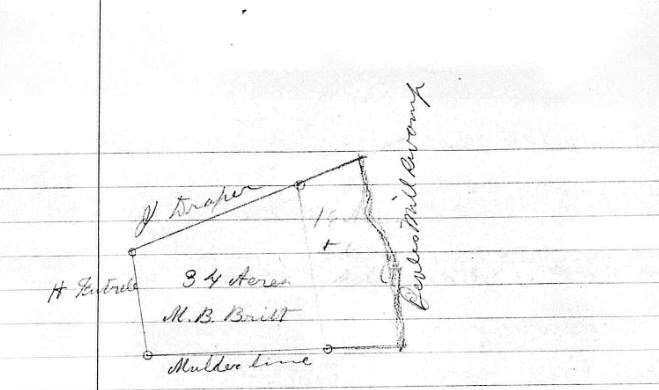
Map of Britton Cumbo Jr. Northampton County Landholdings
Ninth Generation:
The Cumbos of Rich Square
9. MATTHIAS CUMBO (Britton Jr8, Britton Sr.7, Cannon6, Elizabeth5, Gideon4, Richard3, Emanuel Jr. 2, Emanuel Sr.1) is found in the 1850 census for Northampton County as a 5-year-old child living with his parents Britton and Mary Cumbo, and siblings James, Sarah, and Virginia59. In 1866 he married Lousia Pope, 13 years his senior who was the daughter of Elias Pope, head of a household of free people of color and neighbor to the Cumbos in Northampton. Matthias and Lousia had four children together6061.
- Elizabeth Florence Cumbo (b.1866) m. Edward Biggs62
- Susan Cumbo (b.1869)63
- Elias Kendrick Cumbo (b.1871) m. Tabitha Mitchell64
- John William Cumbo (b.1873)65 m. Bessie Joyner66
Matthias sustained his family through farming and was a landowner in Northampton. His legacy in community remains through his generosity.
According to recorded church history, in 1895 Cumbo Chapel in Rich Square, Northampton was named after Matthias Cumbo, nicknamed Bug, who donated the land on which the church was built67. The historic Cumbo Chapel Baptist Church is in Rich Square, North Carolina, a mile south of the Potecasi community where Matthias Cumbo grew up.

Cumbo Chapel Baptist Church
Courtesy Andre Kearns
Tenth Generation:
A Mixed Marriage
My great-great grandmother Florence Cumbo (b. 1866) married Edward Biggs in Northampton County Dec 17, 188968. While they were both African descended, this was a mixed marriage because Edward was born to an enslaved family in neighboring Bertie County, North Carolina and Florence to a free family of color in Northampton. Free people of color in the south were non-white and not enslaved, were born free or manumitted, and were of African and or Native ancestry.
According to US Census records in 1790 there were 4,975 free people of color in North Carolina69. By 1860 this population had grown 6-fold to 30,463. By 1860 free people of color were roughly 10% the size of the North Carolina enslaved population and 3% of the total population70. Post emancipation, new communities of formerly enslaved persons formed building new lives together as free people. Many of these communities grew side by side with established free communities of color, creating opportunities for intermarriage. Between 1890 and 1900 Edward and Florence Biggs moved to Suffolk, Virginia, one of the largest cities in the area, likely so Edward could search for work. Florence and Edward had 5 children together.
- Lucy Biggs (b.1891)71
- Louise Biggs (1894-1982) m. Albert Laury72
- Clara Biggs (1896-1987) m. Charles Ballard73
- Edward “Buddy” Biggs (1898-1983)74 m. Pauline Ballard75
- Sarah Ann “Annie” Biggs (1902-1930) m. James Richards, my great grandmother76
Summary: A Dream Fulfilled
This final generation connects the dots from my great-great grandmother Florence Cumbo Biggs to Emanuel Cumbo, and to his parents Emanuel and Joan of Ndongo. Tracing my Cumbo ancestry was made possible by documentation available on free people of color and required exhaustive searches of all available records to uncover direct evidence coupled with the application of Cumbo cluster analysis to build proofs where direct evidence was missing. This research reveals a powerful ancestral story that all Americans should know; a story of an African man and woman’s resilience and agency over bondage to build a free life for their son and future generations; of Emanuel Cumbo, the Black Virginia Cavalier of James City, of his descendants who lived as free people in America. Most importantly, this research journey has helped me to realize a lifelong dream that Alex Haley seeded into my mind and heart as a young child, to trace my ancestry back to named ancestors born on the continent of Africa.

Cumbo Family Migration
Cumbo Pedigree & Family Migration for Andre Kearns
The letters [A-F] connect Cumbo ancestors to locations on the map of Virginia and North Carolina, found below the pedigree.
| Generation 1 | Emanuel (B. abt. 1600) & Joan (B. abt. 1610) Ndongo/Point Comfort [A] |
| Generation 2 | Emanuel Cumbo B. abt. 1634 James City, VA [B] |
| Generation 3 | Richard Cumbo B. abt. 1667 of Charles City, VA [C] |
| Generation 4 | Gideon Cumbo B. abt. 1702 of Brunswick, VA [D] |
| Generation 5 | Elizabeth Cumbo B. abt. 1728 Brunswick, VA [D] |
| Generation 6 | Cannon Cumbo B. abt. 1758 Greensville, VA (formerly Brunswick) [D] |
| Generation 7 | Britton Cumbo Sr. B. 1776/96 of Northampton, NC [E] |
| Generation 8 | Britton Cumbo Jr. B. 1825 Northampton, NC [E] |
| Generation 9 | Matthias Cumbo B. 1845. Northampton, NC [E] |
| Generation 10 | Elizabeth Florence Cumbo B. 1866 Northampton, NC [E], D. Aft 1902 Suffolk VA [F] |

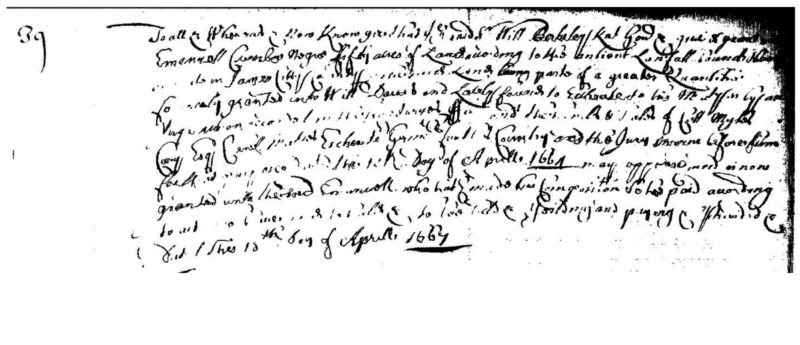

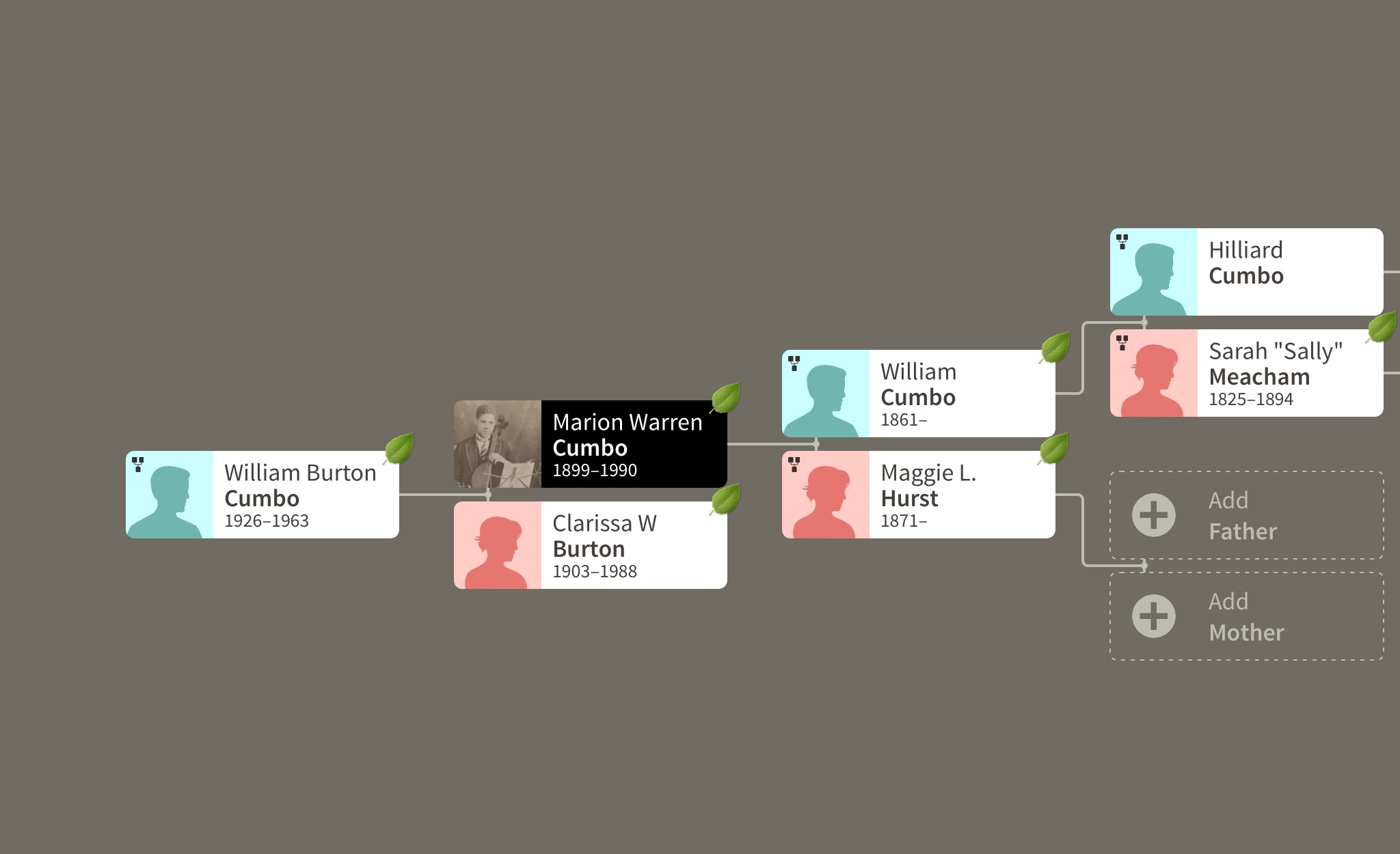



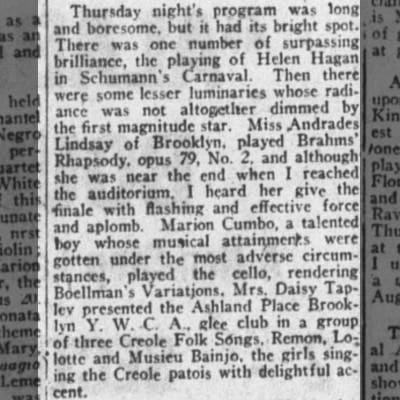


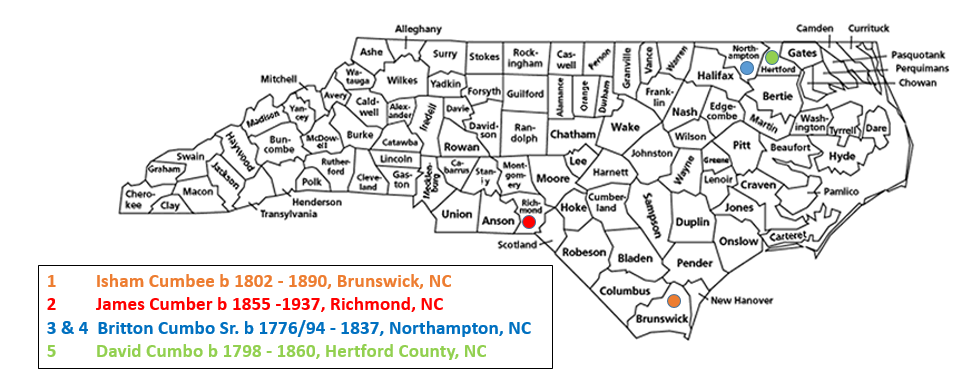


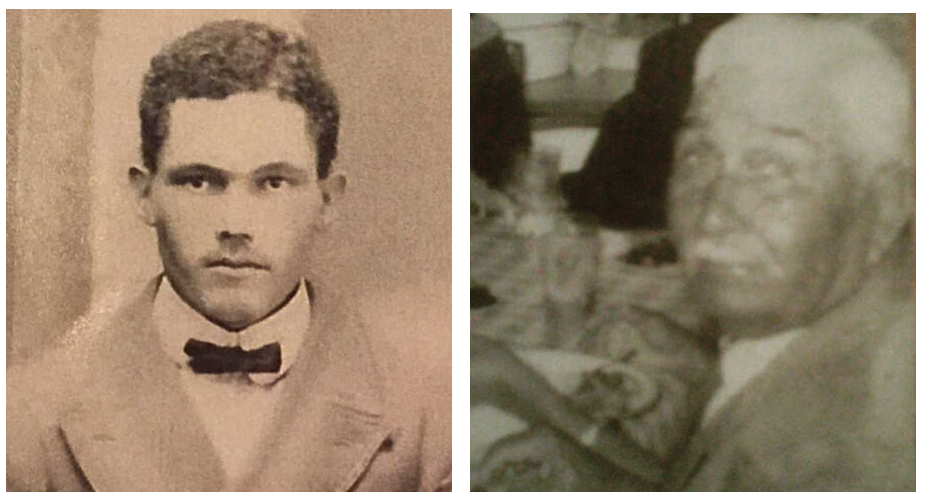

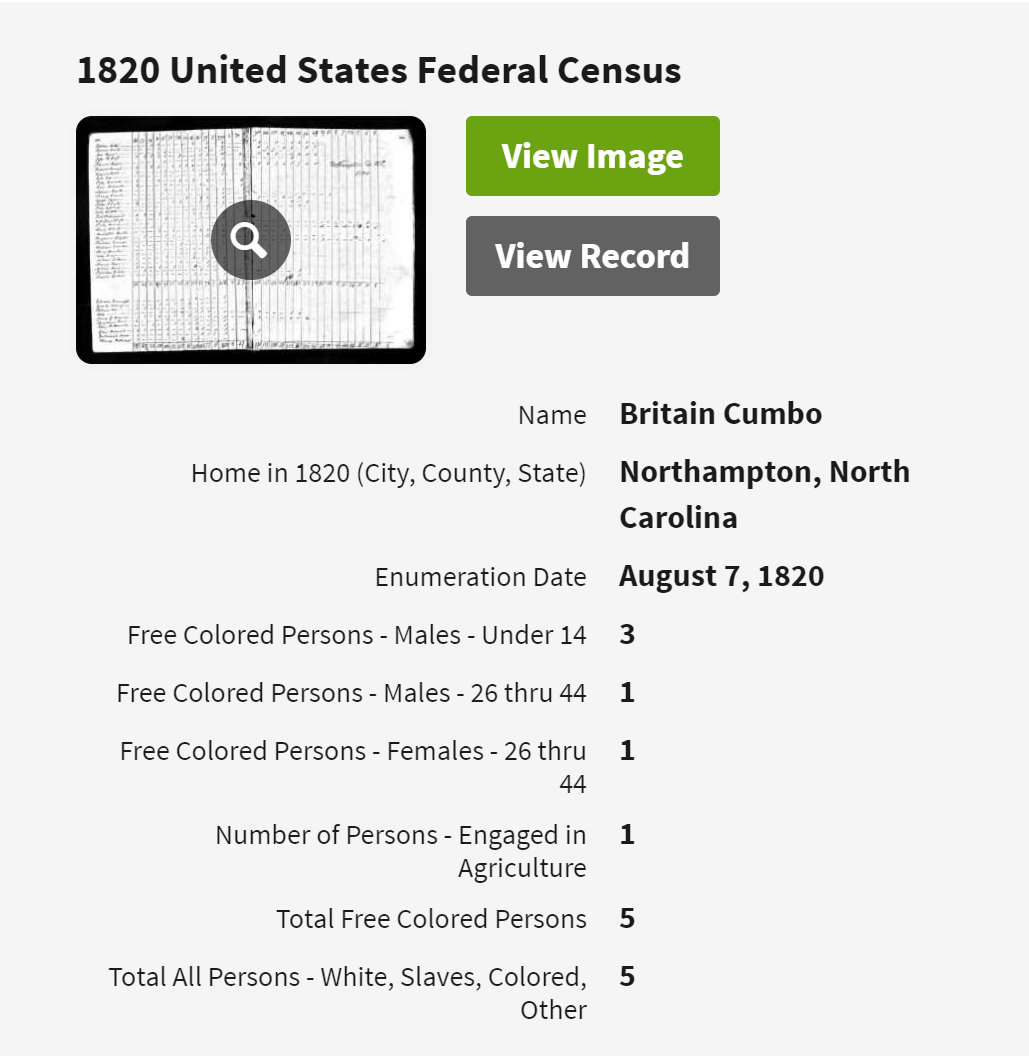

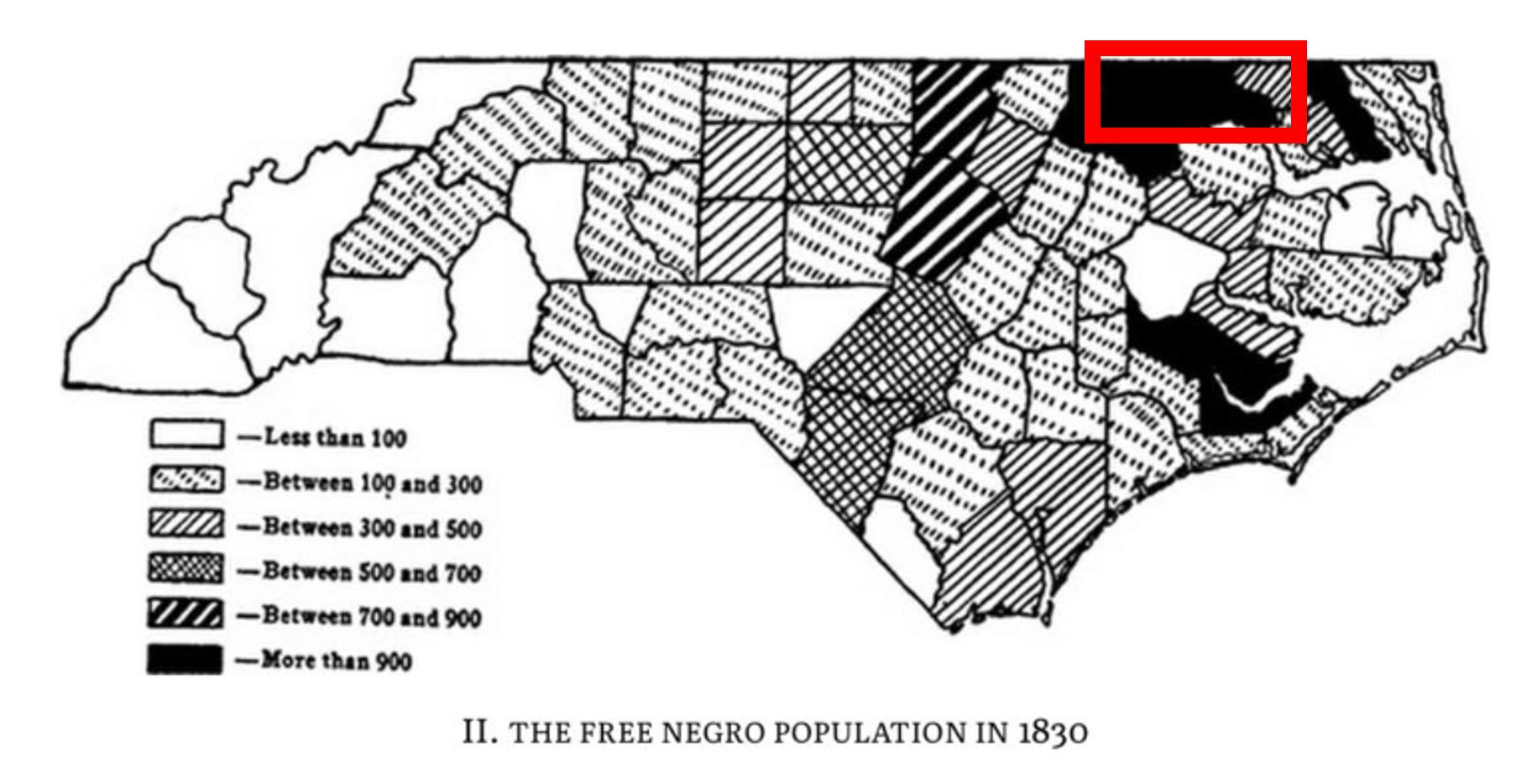 Here’s a mapping of the free colored population for North Carolina in 1830 according to John Hope Franklin’s book The Free Negro in North Carolina. As you can see in 1830, Northampton and Hertford Counties had the largest concentration of free people of color of any other county in the state. The rationale for looking at neighboring counties for Cumbo connectinos is that land was scarce, so while family members might have wanted to live next to each other, they may have had to settle for living in neighboring counties.
Here’s a mapping of the free colored population for North Carolina in 1830 according to John Hope Franklin’s book The Free Negro in North Carolina. As you can see in 1830, Northampton and Hertford Counties had the largest concentration of free people of color of any other county in the state. The rationale for looking at neighboring counties for Cumbo connectinos is that land was scarce, so while family members might have wanted to live next to each other, they may have had to settle for living in neighboring counties.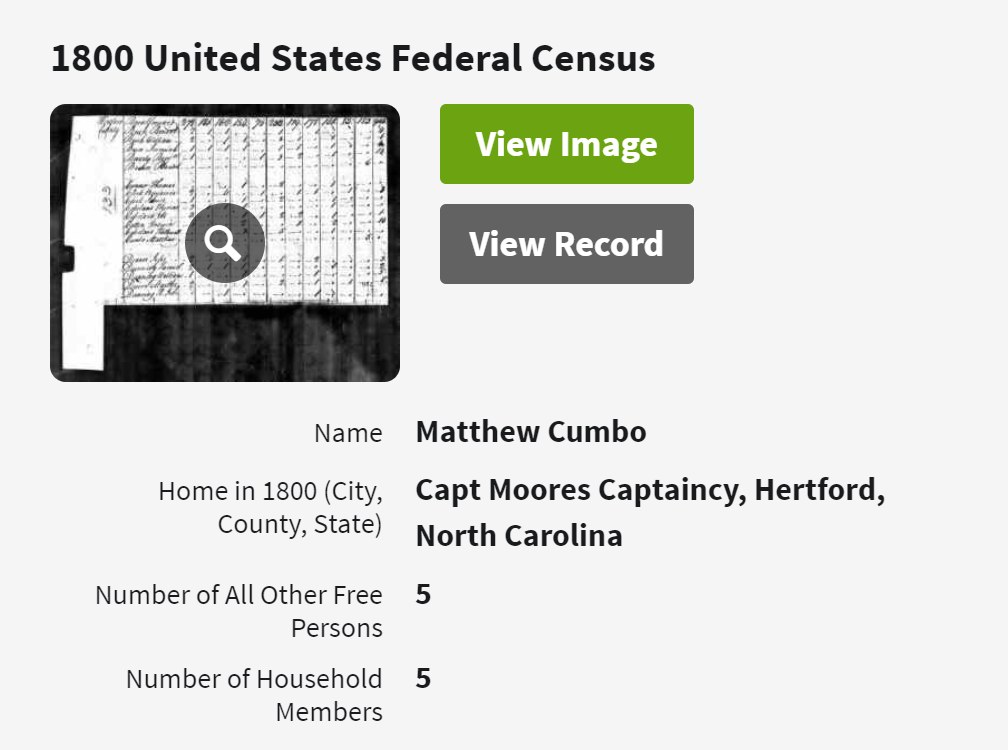

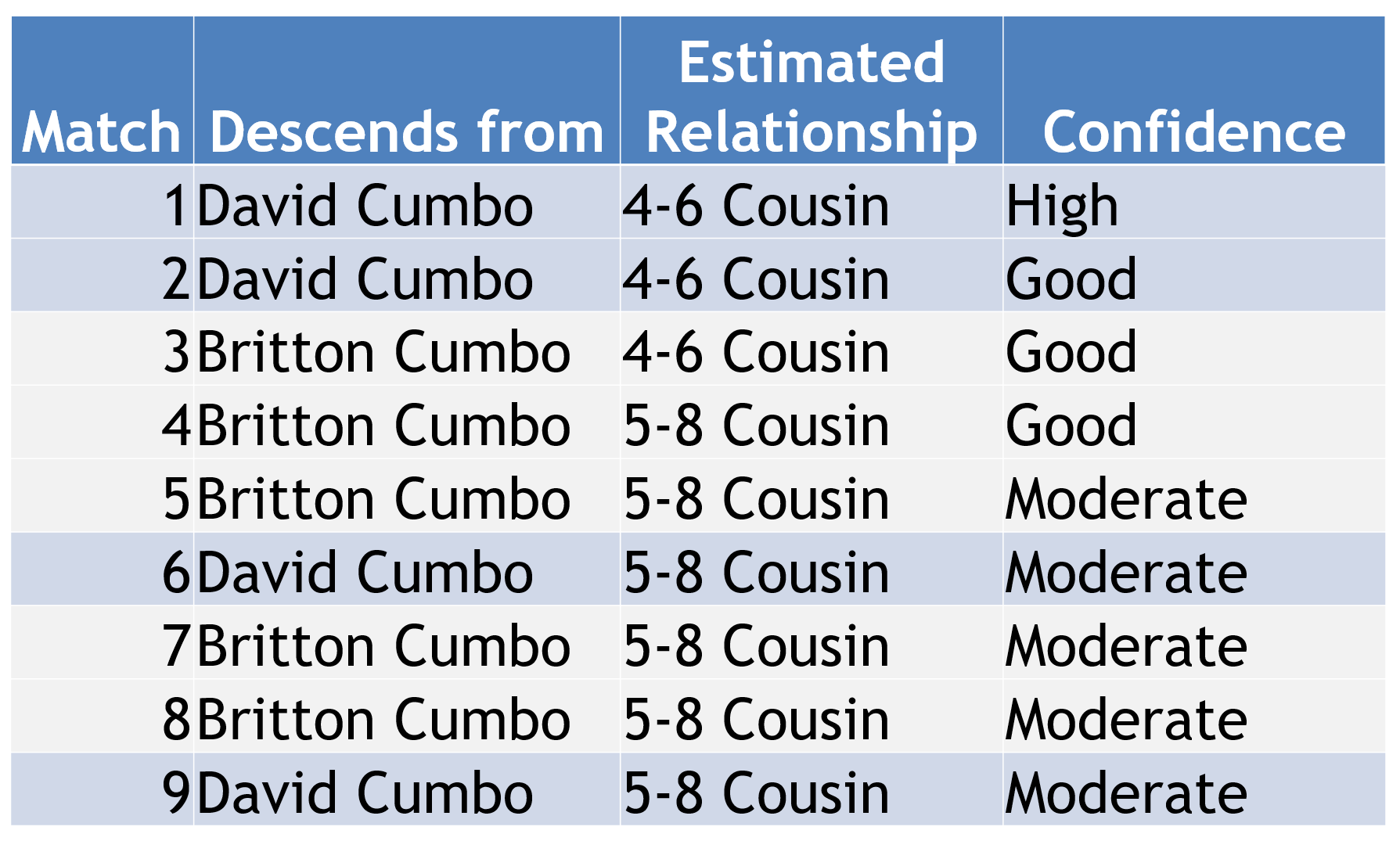
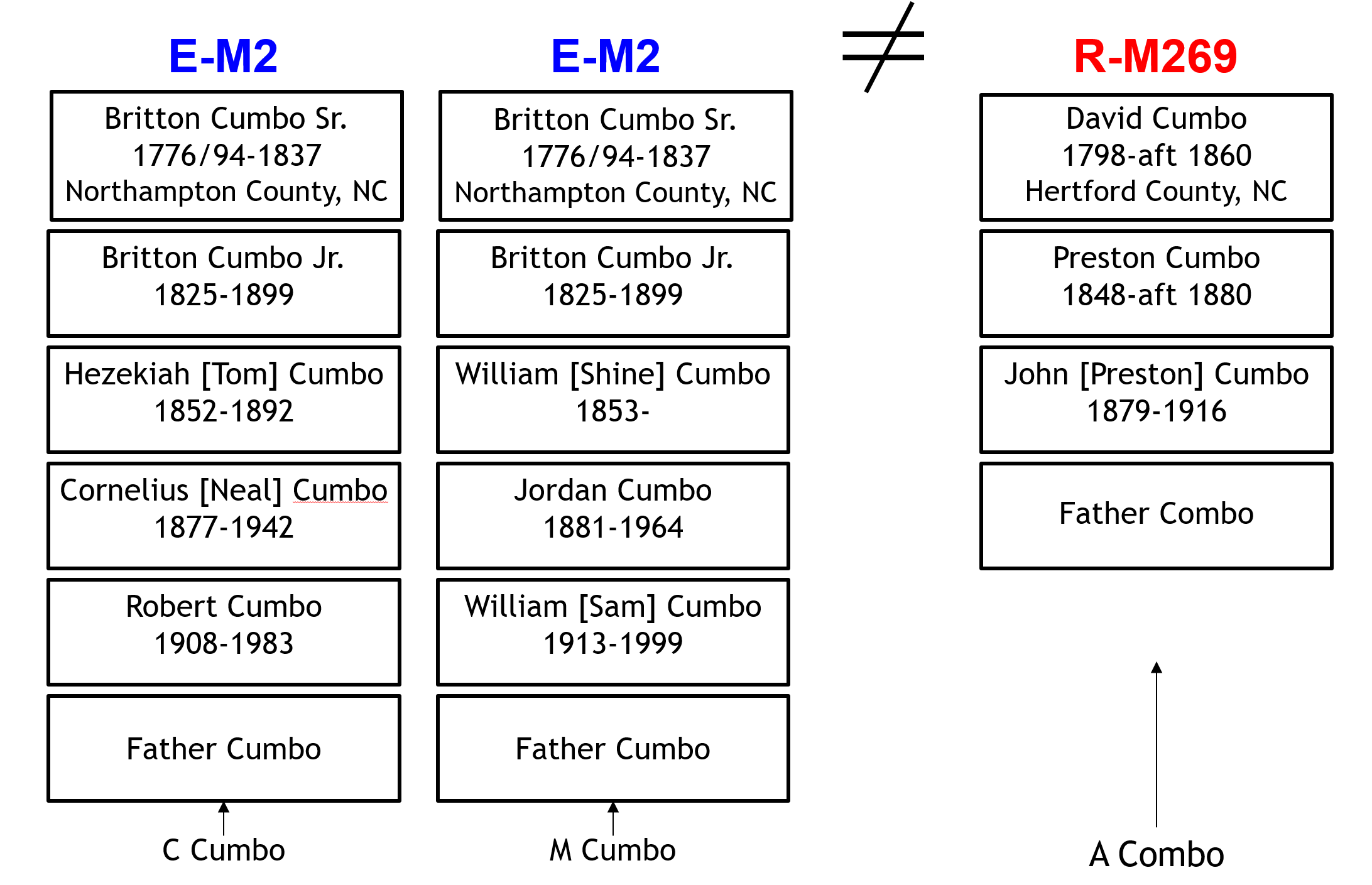
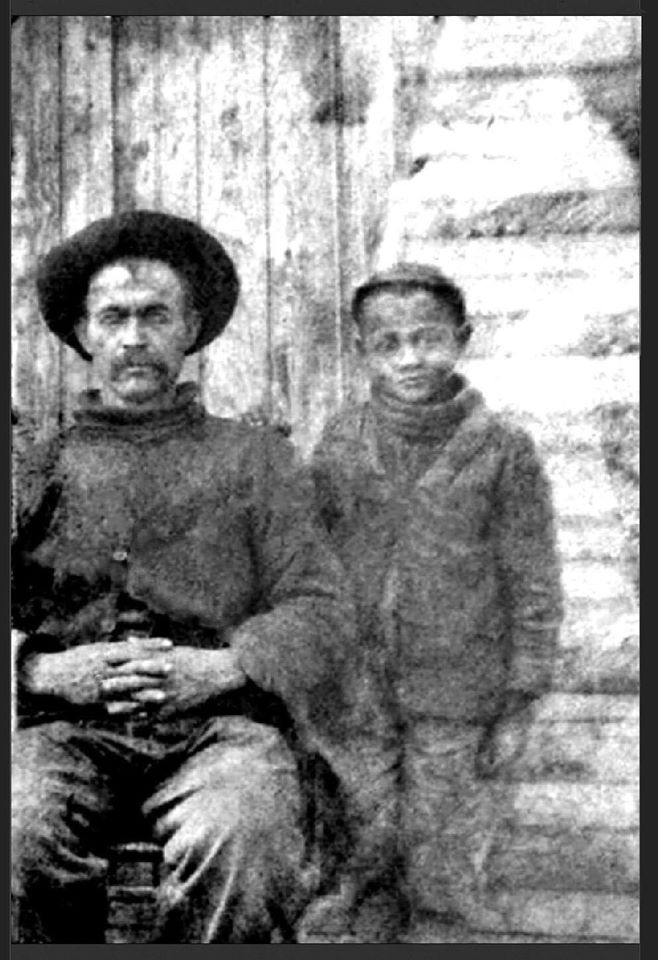
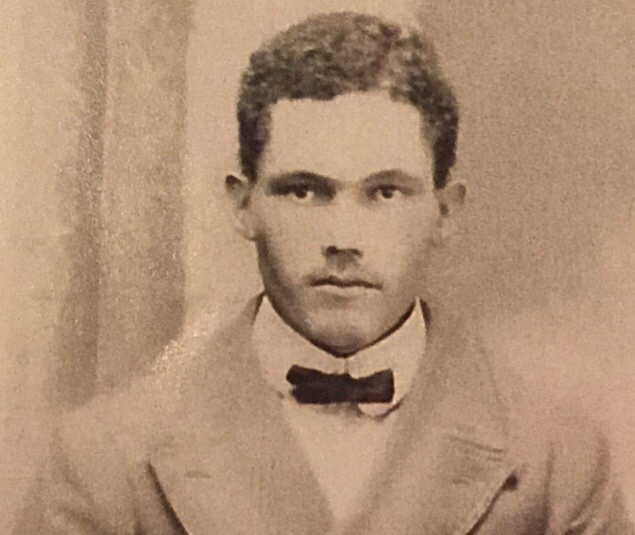
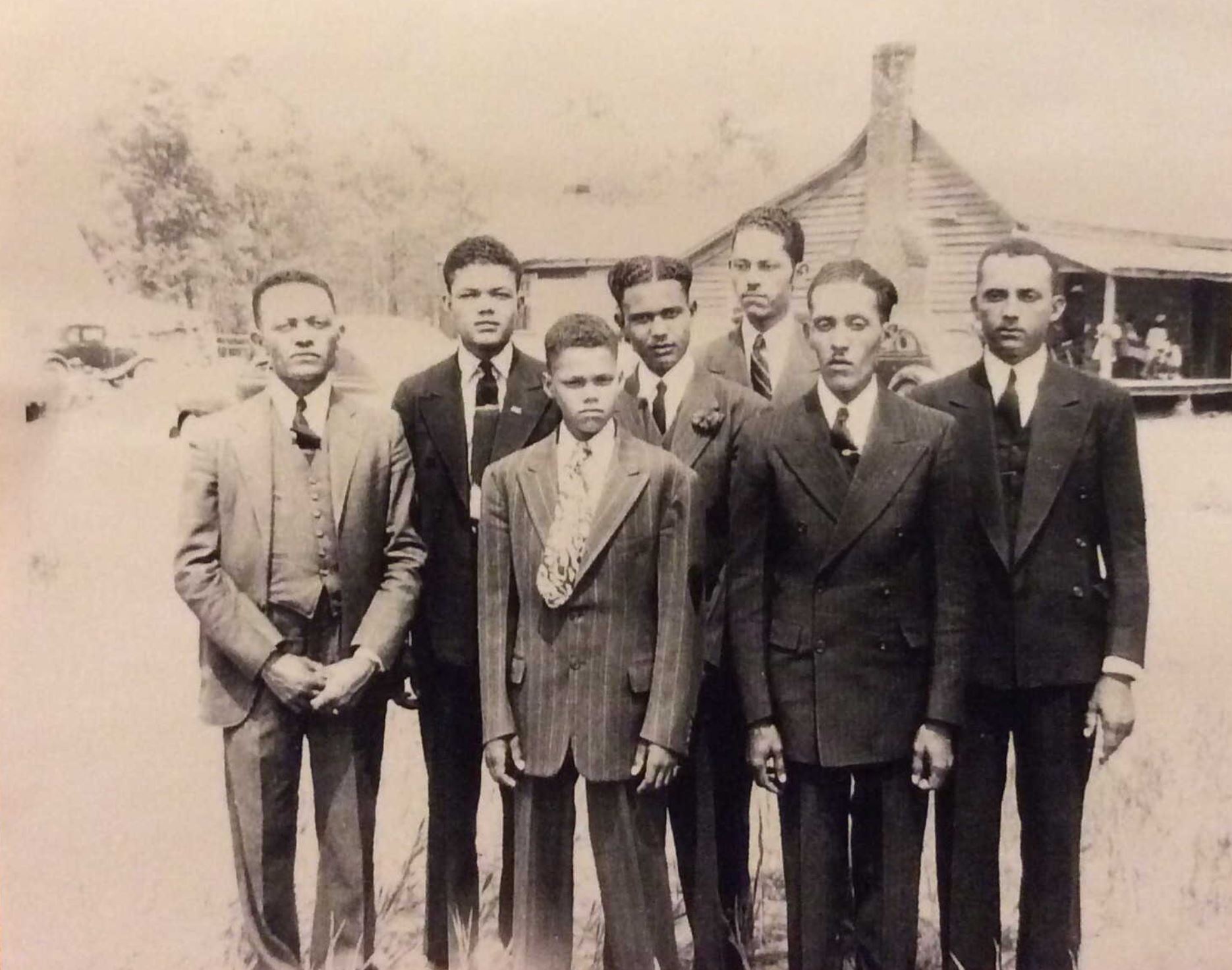
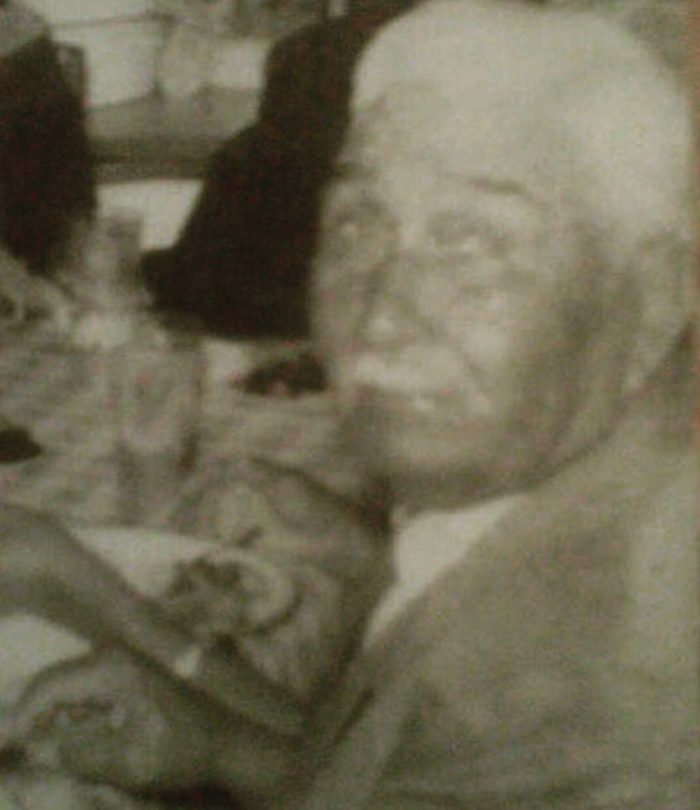

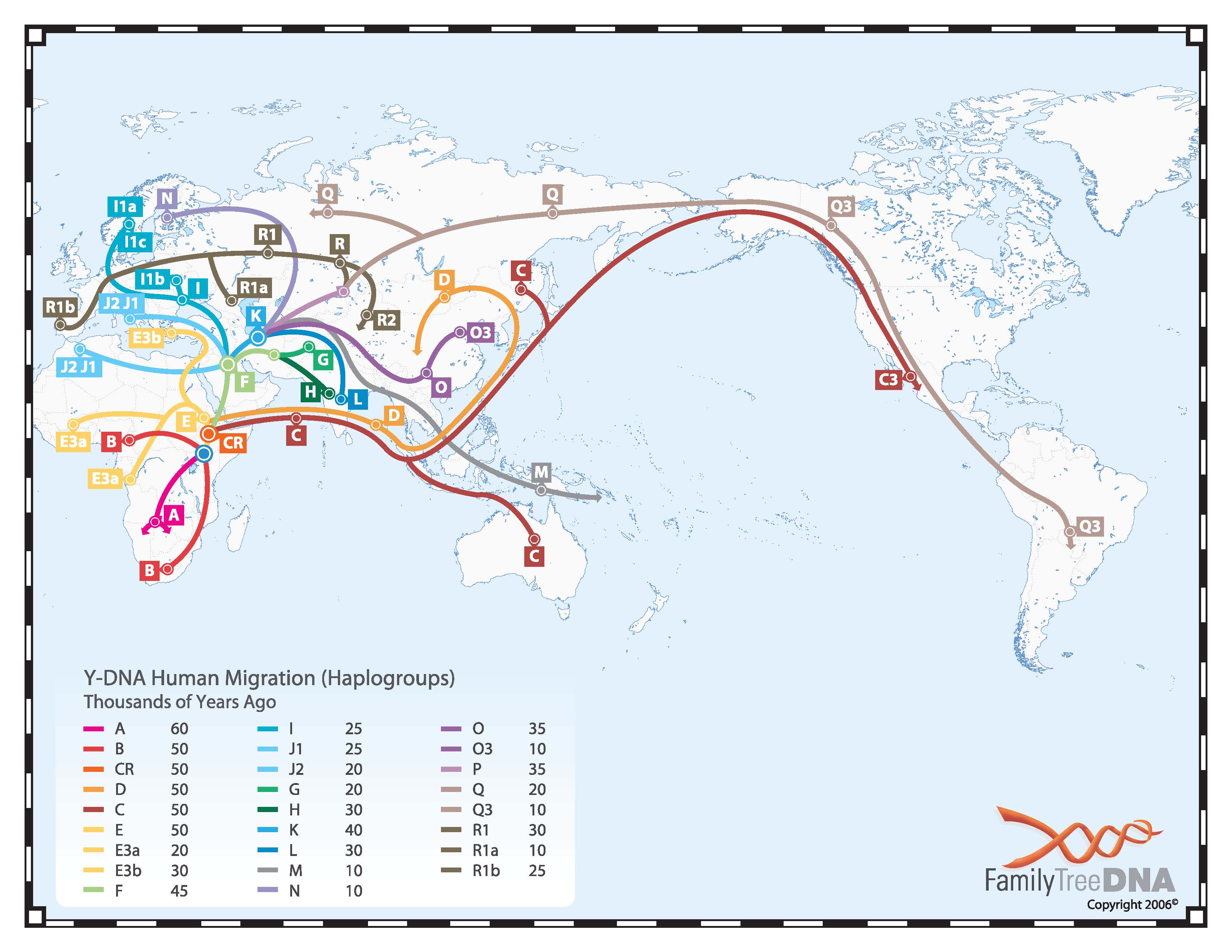 Y-DNA Hapolgroup descriptions.
Y-DNA Hapolgroup descriptions.
